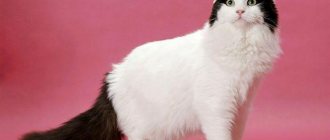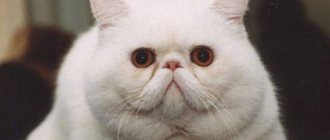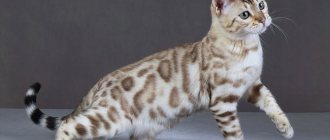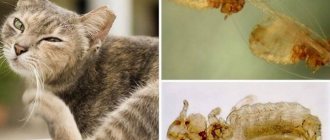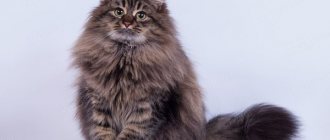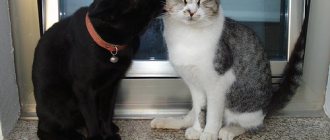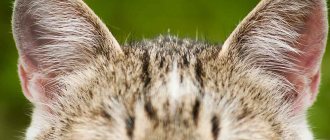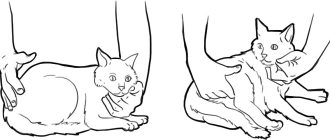The color of a cat's fur, like its pattern, length and texture, is determined by genetics. Understanding how different colors are formed is quite difficult because many genes are involved in the process. If you understand this issue thoroughly, you can easily combine different colors of animals for mating and obtain the required colors.
Differences in color are determined by the physical parameters of the hair and do not depend on the breed of the cat. An animal can display the color of a particular variety without actually being it. For example, a Siberian might wear the color-point pattern that is stereotypical of a Siamese cat.
Mr. Cat Explains: About the Genetics of Colors
Various alleles and genes are responsible for the formation of coat color. The basic shades and patterns of a cat's fur are determined by fewer than ten genes.
It is easier to understand the question of how the colors of a cat’s fur are formed by considering groups of colors. They are usually divided into:
- Solid or solid;
- Ticked;
- Tabby;
- Tortoiseshells;
- Shaded or smoky;
- White;
- Color-point or acromelanistic;
- Silver and gold.
Group of solid colors
The gene responsible for dark tones B/b promotes the production of an enzyme that is involved in the metabolism of the production of the pigment eumelanin.
Its dominant form B produces carbonic eumelanin. It has two recessive forms, b (chocolate) and b1 (cinnamon), with b1 being recessive to B and b.
The chocolate color has a rich brown color and is called chestnut in some breeds. Cinnamon is light reddish brown.
The sex-linked Orange O/o allele predicts whether a cat will produce eumelanin. In animals with red fur, pheomelanin (orange pigment) completely replaces eumelanin (black or brown pigment).
The orange gene is located on the X chromosome. The orange allele is O and is dominant to the non-orange o.
Males are most often orange or non-orange, as they have only one X chromosome. Since females have two X chromosomes, they also have two alleles of the Orange gene.
The combination of OO genes produces orange fur, oo produces black or brown fur, and Oo produces tortoiseshell fur, where some parts are red and others are not. Read whether there are tricolor male cats.
Male tortoiseshells are known to exist, but genetics suggest they are rare and often exhibit chromosomal abnormalities. Typically, less than a third of Tortie cats have a simple mosaic of XXY chromosomes, although Klinefelter karyotypes (genetic chimerism) do occur, and about a third have no XXY components at all.
The orange color is usually called red by breeders. Its other names are yellow, ginger and marmalade. Typically show red cats are bright orange in color, but they can also be yellow or light tan in color.
Orange is epistatic (dependent) on other alleles, which is why all red cats are tabbies. Solid red show cats tend to be low-contrast tabbys.
The color density gene D/d is a carrier protein and is involved in the transport and deposition of pigment in growing hairs.
When a cat has two of the recessive d alleles (Maltese breeding), black fur becomes "blue" (appears grey), chocolate fur degenerates into "lilac" (appears light brown), cinnamon fur becomes fawn, and red fur becomes cream. .
Other genes are also involved in the formation of coat color:
- Barrington Brown is a recessive darkening gene that dilutes black to mahogany, brown to light brown, and chocolate to pale coffee. It is different from the browning gene and is observed only in experimental cats.
- The dilution modifier gene Dm “caramelizes” and weakens dominant colors. The existence of this phenomenon as a separate gene is a controversial issue among felinologists.
- A mutation in the E/e expansion locus (melanocortin receptor) changes the black pigment to amber or light yellow. This phenomenon was first identified in Norwegian forest cats.
- A modifying factor has also been suggested for shaded silver Persians and chinchillas, whose fur becomes pale golden in adulthood due to low levels of pheomelanin production. The fur of these cats appears to be shaded. This is likely due to a phenomenon known as "tarnish" in silver.
Prominent representatives of solid colors are British Shorthair, Russian Blue, Nibelungen, Chartreuse.
British Shorthair
Russian blue
Nibelung
Chartreuse
We recommend an article about gray cat breeds.
The color of a cat as a guarantee of its uniqueness
No one will argue that cats are very different. And we are talking here not only and not so much about the breed, since even within the same breed, animals can differ significantly in appearance. It's about color.
Photo gallery: Persian cats of different colors
The red Persian cat always has stripes on his fur.
The stripes on the coat of a cream-colored Persian cat are almost indistinguishable
The Persian cat has a blue coat with an even, uniform tone.
The Persian cat of the Himalayan red color has a very light body, and the paws, tail, muzzle and ears are darker
The colors of cats are endlessly varied: from the deceptively simple to the most amazing and imaginative. And what kind of fur coat a kitten will have depends on its heredity, on the blood of its parents.
Amazing pigment
In fact, the color of any cat is determined by three main factors:
- coat color;
- intensity of fur color (for example, a cat can be black, or maybe dark gray);
- the presence or absence of a pattern on the wool.
At the same time, there are not and never have been two cats of exactly the same color in the world. And all this riot of colors and shades is provided with the help of a single coloring substance contained in animal fur - the melanin pigment. More precisely, two varieties of this pigment: eumelanin, responsible for black coloring, and pheomelanin, responsible for red (orange, yellow) coloring. So cats have only two basic colors: red and black.
At the same time, the mechanism of cat heredity works in such a way that for female cats there are three possible color options (red color, black color and their “mixture” - tortoiseshell red-black color), and male cats can be either black or red.
A tortoiseshell-colored cat has a fur coat full of black and red (orange, red, yellow) spots.
In fact, in nature sometimes there are cats of “tortoiseshell” color, but these are single specimens, the fruits of a gene mutation. And, unfortunately, such cats do not produce offspring.
White color
White color also belongs to the solid or solid color, but due to the difficulties of its reproduction, it is separated into a separate group.
It has long been thought that white spotted and dominant white colors are created by two separate genes, but in fact they are both found on the KIT allele.
White patches can take many forms, from a small marking to the profuse snow pattern of a Turkish Van, while epistatic white produces a completely snow-white cat.
Turkish van
The main characteristic of the Burmese cat, specific recessive “gloves,” are also produced by this gene.
Burma has white paws
The KIT allele has the following modifications:
- WD is a dominant white color associated with blue eyes and deafness. Deafness occurs due to a reduction in the population and survival time of melanoblast stem cells, which in addition to establishing pigment-producing colonies develop into a variety of neurological types. White cats with one or two blue eyes are especially likely to be deaf.
- WS – white spot. This gene shows variable expression, with heterozygous cats being anywhere between 0-50% white and homozygous cats being 50-100% white.
- w – wild type, without white spots.
- wg is a recessive gene, and it is its presence that is responsible for the appearance of “gloves” in Burmese cats.
Read the article about the breeds of white cats, as well as about the signs about them.
Thus, the allele that causes a cat to have white fur is the dominant masking gene. As a result, the cat will have a basic color and pattern. However, when a dominant white gene is present, this pattern will not be expressed. A cat that is homozygous (WW) or heterozygous (Ww) for this gene will have white fur. A cat that lacks this dominant masking gene (ww) will have a different coat color.
A common misconception is that all white cats with blue eyes are deaf. It is possible to have a cat with a natural snow coat without this gene, as an extreme form of white patches, although this is rare - usually the animal is left with a small mark of a different color on the body. Although congenital sensorineural deafness is common in white-coated domestic cats, it is caused by degeneration of the inner ear.
Deafness can occur in white cats with yellow, green, or blue irises, but is most common in the latter. It has been found that in white cats with different colored eyes, deafness most often affects the ear on the blue-eyed side.
One 1997 study of white cats with varying degrees of hearing loss found that 72% of the animals were completely deaf. The entire organ of Corti degenerated within the first few weeks after birth; however, even during this period, no brainstem responses could be evoked by auditory stimuli, suggesting that these animals never experienced any auditory sensations.
It has been found that 17 to 22% of white cats with non-blue eyes are deaf, 40% of odd-eyed snow cats with one blue eye are deaf, and 65 to 85% of blue-eyed white cats also cannot hear at all.
The Anatolian cat can be partially or completely white.
Turkish Vans are also partly white. They can also be completely white, but in this case they are considered mestizo, a cross with the Turkish Angora.
Turkish Van: cat and kittens
Turkish Angoras, Persians, Siamese (Foreign Whites), Cornish Rex, Khao Mani, Russian White, British Shorthair and Scottish Fold and others can be completely white.
Scottish lop-eared
Russian white
Persian
Foreign white
Cornish Rex
Khao-mani
White color
Agouti and non-Agouti, Ticking and Tabby
Tabby cats are tabby due to the Agouti gene. Their markers have an even distribution of pigment, while the background consists of hairs colored along their entire length in different colors.
Common signs of tabby cats are as follows:
- A mark on the forehead in the shape of the letter "M", which is clearly visible in clear tabbies and slightly visible in ticked ones.
- A mask of thin lines (“pencil lines”) on the muzzle; this feature is also more pronounced in striped and spotted individuals.
- Framing the eyes in the form of black rings with white rings on top.
- Dark coloration of the mouth and paw pads.
- The nose sometimes retains a pink tint, but is either darker than in respectable ones, or has a pigmented rim.
- Stripes encircling the body, limbs and tail. They “dissolve” on the body of ticked cats.
The Agouti A/a gene is a signaling protein. The dominant wild type A causes the Agouti shift phenomenon, which manifests itself in a flattening of black and red hair coloration (revealing the basic tabby pattern), while the recessive non-Agouti or "hypermelanistic" allele A, prevents this shift towards pigmentation.
Toyger cat
The homozygous aa form produces black pigment throughout the hair growth cycle. Thus, the non-Agouti (aa) genotype masks or hides the stripe pattern, although suggestion of an underlying pattern (called "ghost stripe") can sometimes be seen, especially in kittens.
The O allele is also epistatic over the non-Agouti genotype. That is, as a mutation it has no noticeable effect on red or cream cats, causing them to develop striped stripes regardless of their genotype at this locus. This explains why it is common to see a striped pattern on the orange spots of non-Agouti cats.
Prominent representatives of these colors are Abyssinians and Chausies (ticking), Bengals, Toygers, Savannahs, Serengeti, Ocicats (tabby).
Abyssinian
Chausie
Bengal
Savannah Teuger
Ocicat
Description
These meowing cuties are distinguished not only by the variety of their skins, but also by their elegance. They have a small wedge-shaped head, large and pointed ears, and medium-sized almond-shaped eyes.
Their neck is long and thin, their body is muscular, small but long. The forelimbs are shorter than the hind limbs, and the tail is very long and tapers towards the end.
The fur of these creatures shines and shimmers in the sun, it is short and smooth. The weight of adult pets is approximately six kilograms. The eyes depend on the fur; they are blue or dark blue, of different depths and transparency.
The nature of animals has its own characteristics, not everyone will like it, but those who find a common language with it will become their best friend. These purrs are proud and expressive, independent and energetic.
They are often stubborn, but if they feel love and respect from the owner, they pay him in the same coin. We must treat them kindly and not give reasons for jealousy. Tailtail will not tolerate other animals in the house, and she does not like strangers either.
She can scratch small children if they are too intrusive. She is not afraid of loneliness and stays calmly in the house while everyone is at work, but in the evening it is advisable to play with her so that she knows that you love her. She hunts well, is trainable, can sit and fetch a ball. These fluffies love to communicate and often speak their own language, purring with many different intonations.
Tortoiseshell colors
Genetically, Tortie cats are tortoiseshell in every way except that they express the white spotting gene.
However, there is one anomaly, generally the larger the white areas, the smaller and larger the patches of tan and dark or striped areas.
Unlike Torti, cats that do not have white spots usually have small markers of other shades or even areas that are figuratively called “salt and pepper.” This reflects genetic influences on the relative rate of melanocyte migration and X-inactivation in the embryo.
Serious research on tortoiseshell cats began around 1948, when Murray Barr and his graduate student E.G. Bertram noticed dark, drumstick-shaped masses inside the nerve cell nuclei of female cats, but not those of males. These areas became known as Barr bodies.
In 1959, Japanese microbiologist Susumu Ono determined that Barr bodies were X chromosomes. In 1961, Mary Lyon proposed the concept of X-inactivation, where one of the two X chromosomes inside a female mammal is switched off.
Calico cats are almost always female because the gene locus for orange/non-orange coloration is on the X chromosome. In the absence of other influences such as color inhibition that causes white fur to be produced, the alleles present at these orange loci determine whether the hair is red or not.
Female cats, like all female mammals, usually have two X chromosomes. In contrast, placental male mammals, including chromosomally stable male cats, have one X and one Y chromosome. Since the Y chromosome does not have a locus for the red gene, there is no chance that an XY male could have both the orange and non-orange genes together, which is necessary to create the tortoiseshell coloration.
The only exception is that in rare cases, defective cell division can leave an extra X chromosome in one of the gametes that is capable of reproducing a male cat. This extra X chromosome is then copied in each of his cells, causing a condition called XXY, or Klinefelter syndrome.
All but about one in three thousand rare tortoiseshell males are infertile due to a chromosomal abnormality.
Tortoiseshell color is characteristic of many elite varieties, it is especially common in female Maine Coons, Siberian cats, Neva Masquerade cats, Norwegian Forest cats, but is also characteristic of outbred pets.
Color point and albinism
The color point pattern is most often associated with Siamese cats, but can also appear in any domesticated cat.
Such an animal has a dark mask on the face, ears, paws and tail, with a lighter version of the same color on the rest of the body and perhaps some white.
Color Point Ragdoll
The exact shade of the color pattern depends on the actual coloring, so there are various points - dark brown, chocolate (warm light brown), blue (dark grey), lilac or frost (silver-gray-pink), red or orange, tortoiseshell.
This pattern is the result of a temperature-sensitive mutation in one of the enzymes in the tyrosine-to-pigment metabolic pathway, such as melanin. Thus, little or no pigment is produced, except on the extremities or points where the skin is a little colder. For this reason, color point cats tend to darken as they age as their body temperature drops.
In addition, due to significant trauma, fur can sometimes also darken or lighten as a result of changes in body temperature.
Mutations in the early stages of the tyrosine pathway can affect not only pigment but also neurological development. This leads to a higher incidence of squinting eyes in colorpoints.
The gene responsible for acromelanistic colors and albinism is designated C and exists in the following modifications:
- C – full color.
- cb – Burmese sepia pattern, similar to color dot but with lower contrast.
- cs – Siamese color. This combination is similar to cb, cb/cs cats have a medium contrast phenotype known as the mink coloration.
- ca – blue-eyed albino.
- c – albino with pink or red eyes.
The Siamese and all breeds derived from it, for example, the Sacred Burma and Ragdoll, have color-point colors.
Drawing on the fur of cats
Cats of red and cream colors always have a pattern on their coat.
A variety of coat patterns allows you to get kittens with individual color characteristics. In order to obtain the desired color with the maximum probability, breeders study genetics and, based on new knowledge, look for parents for future offspring. Ordinary pet owners rarely think about the need for selection.
Tabby (tabby cats)
Tabby is the most common color of cats; this word also means the presence of a pattern on the coat - stripes or spots. Breeding such pets is difficult - the result can be quite unexpected.
Solid (solid) and smoky cats
If the cat is completely one color, this color is called solid. Such cats almost never have a pattern on their fur.
If the cat is black or blue, but the roots of the hair are clearly white - smoke (from English “smoke”). The roots of the hair of cats of the same color are usually greyish, but true “smoke” cats have distinct white roots, the color remaining only on the top part of the hair.
White marks
Cats of any color may have distinct white markings. The name of the color depends on their size and position.
Tortoiseshell cat color
Cats with similar coat colors have a combination of random spots of red and black throughout their body.
Color point
Cats of this color are characterized by darker areas than the main color at the end of the muzzle, tips of the ears, paws, and tail.
Cats of this color are born completely white and gradually darken. The older the animal, the darker the spots.
Colors accepted by the International Cat Federation (FIFe)
| Code | International color designation | Translation |
| A | Blue | Blue |
| B | Chocolate, brown, chestnut | Chocolate, brown, havana (champagne color) |
| C | Lilac, lavender | Lilac, lavender (platinum) |
| D | Red, flame | Red, fiery |
| E | Cream | Cream |
| F | Tortoise-shell, patch | Tortoiseshell, spotted |
| G | Blue-cream, blue-tortie | Bluish cream, bluish tortoiseshell |
| H | Chocolate-tortie | Chocolate tortoiseshell |
| J | Lilac-tortie | Lilac tortoiseshell |
| N | Black/ebony, seal, sable, ruddy | Black/ebony, seal, sable, wild |
| O | Sorrel, cinnamon, honey | Sorrel, red-brown (brown), honey |
| P | Beige fawn | Yellow-brown (“fawn beige”) |
| Q | Sorrel tortie | Red-brown tortoiseshell |
| R | Beige fawn cake | Tan tortoiseshell |
| S | Silver, smoke | Silver, smoky |
| U | Bronze | Bronze |
| W | White | White |
| Y | Golden | Golden |
| Z | Marble | Golden tortoiseshell |
| X | Unregistered | Unregistered, unrecognized color |
Color patterns adopted by the International Cat Federation (FIFe)
| Code | International designation | Translation |
| Presence of white in color | ||
| 01 | Van | Wang |
| 02 | Harlequin | Harlequin |
| 03 | Bicolour | Bicolor/bicolor |
| 04 | Mitted/white point | With white markings for color points |
| 09 | Little white spots | White spotting 1-2 cm (rejection for LH*) |
| The amount of tipping in silver colors | ||
| 11 | Shaded | Shaded |
| 12 | Tipped, shell | Veiled |
| Pattern type for tabby colors | ||
| 21 | Tabby, agouti | Striping, agouti factor |
| 22 | Blotched/marble | Marble |
| 23 | Mackerel/tiger | brindle |
| 24 | Spotted | Spotted |
| 25 | Ticked | Ticked or Abyssinian |
| Point color designation | ||
| 31 | Burmese | Burmese |
| 32 | Tonkinese | Tonkinese |
| 33 | Himalayan or Siam | Himalayan or Siamese |
| 34 | Singapura | Singaporean |
| 35 | Abyssinian | Abyssinian |
Silver and gold colors
The silver color in cats is caused by the melanin inhibitor I/i gene.
Its dominant form helps suppress melanin production, but affects pheomelanin (red pigment) much more strongly than eumelanin (black).
In tabby and spotted cats, this turns the background into a sparkling silver, leaving the color stripes intact, creating a silver tabby. In respectable cats, the base of the hair becomes pale, which makes them look like silver smoke, these are the so-called shaded or shaded colors.
Silver Agouti cats can have a range of phenotypes, from silver tabby, silver medium ticking (less than half of the coat is pigmented) to silver-tipped hair (chinchilla coloring).
The amount of pigmentation depends on the hypothetical "broad band" factor. Breeders use this term to refer to the presence of the Wb/wb gene.
If the pet has the broad stripe trait but does not have the inhibitor, the coloration will be gold instead of silver. These cats are known as golden tabbies.
golden tabby
A golden tint is also possible. However, there is no golden smoke because the combination of wide stripe and non-Agouti simply produces a solid cat.
The genetics involved in producing the ideal tabby or ticked cat, as well as the shaded or smoky cat, are complex.
Not only are there many interacting alleles, but genes sometimes don't express themselves fully or conflict with each other. For example, the melanin inhibitor gene in some cases does not block the pigment, resulting in a gray undercoat or darkening (yellowish or rusty fur).
Likewise, poorly expressed non-Agouti or overexpression of a melanin inhibitor causes pale, blurry black smoke.
It is believed that different polygenes (sets of related genes), epigenetic factors or modifier genes, as yet unidentified, lead to different color phenotypes, some of which are considered more attractive by felinologists.
Silver and golden colors are found, for example, in Bengal, British, Scottish cats, and Persian chinchillas.
Silver Bengal
Golden cats
The cat, classified as a rare golden color, looks very noble. Fur of this color can be monochromatic, but more often there are fluffy beauties with “patterns” on their fur coat :
- marble;
- brindle;
- spotted.
There are different shades. From light apricot to dark gold color. Owners of such a rare and chic color are, for example, chinchilla cats. You can also meet golden Siberian, European, Persian and even British beauties.
© shutterstock
Shaded and smoky colors
Genetic influences on this type of coloring have:
- Gen Agouti.
- Tabby pattern alleles such as T (tabby pattern).
- Silver or melanin inhibitor gene.
- Factors influencing the number and width of color bands on each hair (for example, a hypothetical broadband gene).
- Reasons that influence the quantity and quality of expression of the eumelanin and/or pheomelanin pigment.
- Genes that cause coat glitter, such as the shiny coat of Bengals.
- Factors responsible for eliminating residual streaks (hypothetical chaos, disorder, non-confusion, erasing the pattern).
Smoky colors are characteristic of many breeds - Siberian, Russian Blue, Maine Coon, British, Scots, Burmilla.
Fur length and texture
The length of a cat's fur is determined by a gene in which the dominant L form codes for short hairs, and the recessive L form codes for long hairs.
In a longhaired cat, the transition from anagen (hair growth) to catagen (hair cessation) is delayed due to this mutation.
A rare recessive shorthair gene has been discovered in some lines of Persian Silver cats when two longhaired parents produce shorthaired offspring.
The length of a cat's fur is also controlled by the fibroblast growth factor gene. The dominant allele codes for short hair in most cats.
Long fur is encoded by at least four different recessively inherited mutations. The most common of these is found in most or all long-haired breeds, with the other three found only in Ragdolls, Norwegian Forest cats and Maine Coons.
Many genes have been identified that lead to a cat's unusual fur. They have been found in randomly bred cats that are strictly controlled. Some of them are endangered, so such animals are not sold outside the region where the mutation occurred.
In many breeds, coat gene mutations are undesirable. An example is the Rex allele, which appeared in Maine Coons in the early 1990s.
Rexes originated in America, Germany and Britain, where one breeder caused confusion by calling them "Maine waves." Two British breeders carried out mating tests which showed that this was likely a new Rex mutation and that it was recessive.
Rex fur
The animals' coat density was similar to Maine Coons with a normal coat, but consisted only of downy-type hair with a spiral curl. The mustache was more curved, but not curly.
There are various genes that produce curly or "rex" cats. New types of them arise spontaneously from time to time in random breeds of cats.
Here are some of the Rex genes selected by breeders:
- r – characteristic of Cornish Rex, recessive.
- gr – present in German Rexes, recessive. The locus here is the same as in Cornish, but proposed as a different allele. However, most breeders believe that the German Rex has an r/r genotype.
- re - characteristic of Devon Rex, recessive.
- ro – it was possessed by the now extinct Oregon Rex, recessive.
- Se - carried by Selkirk Rex cats, dominant, although sometimes described as incomplete dominance because the three possible pairs of alleles relate to three different phenotypes - heterozygous cats (Sese) may have a fuller coat, which is preferred in the show ring, while as homozygous cats (SeSe) have a tight curl and less hair volume.
- Lp (preliminary) – responsible for the emergence of La Perms, dominant. In this case, Lp/lp and Lp/Lp individuals have the same phenotype.
There are also genes responsible for hairlessness in cats:
- h – its carrier is the French Hairless cat, recessive.
- hd – characteristic of the British hairless cat, recessive.
- Hp – it is possessed by the Don Sphinxes and Peterbalds, dominant.
- hr – responsible for the appearance of the Canadian Sphynx, recessive.
Some Rex cats are prone to temporary hairlessness during shedding, known as alopecia.
Here are a few other genes that lead to cats with unusual fur:
- The Wh gene is dominant, possibly incomplete, leading to the appearance of wire-haired cats. They have bent or crooked hairs that form springy, wiry fur.
- The hypothetical Yuc gene causes cats to be born without undercoat. However, the proportional relationship between guard hair and down coat varies greatly among all breeds.
- A recessive autosomal gene for onion hair that causes roughness and swelling in the hair. Edema occurs due to an increase in the inner nucleus of the medulla cells.
- Recessive autosomal gene spf. The fur of such animals is sparse, the hairs are thin, uneven and curved, there is a brown coating and bare areas around the eyes and nose, chest and belly.
When breed and color are inseparable
The same type of color can be found in cats of different breeds: there are “marbled” Siberian cats and “marbled” British cats, spotted Oriental cats and spotted Bengals, “colorpoint” Persians and “colorpoint” Burmese cats. But there are breeds for which, according to the standard, only one type of color is possible.
Table: some cat breeds with the only type of color allowed for them by the standard
| Color | Mandatory and exclusive for the breed | Allowed for the breed |
| Black solid | Bombay cat |
|
| Striped Tabby | Toyger |
|
| Spotted Tabby |
|
|
| Ticked Tabby |
|
|
Of course, the same type of color looks completely different, for example, on long-haired and short-haired animals.
Photo gallery: cats of different breeds of spotted tabby color
In a short-haired spotted cat of the Egyptian Mau breed, the spots are clearly defined, and on the tail and paws they can turn into stripes. In a silver spotted Siberian cat, the lighter areas of the body are lightened to white. Although the spotted Pallas cat has a characteristic letter “M” (the “scarab” sign) on the forehead spots, his eyes are circled, and his cheekbones are emphasized by the obligatory thin lines
But anyway, cats are amazingly beautiful, right?
